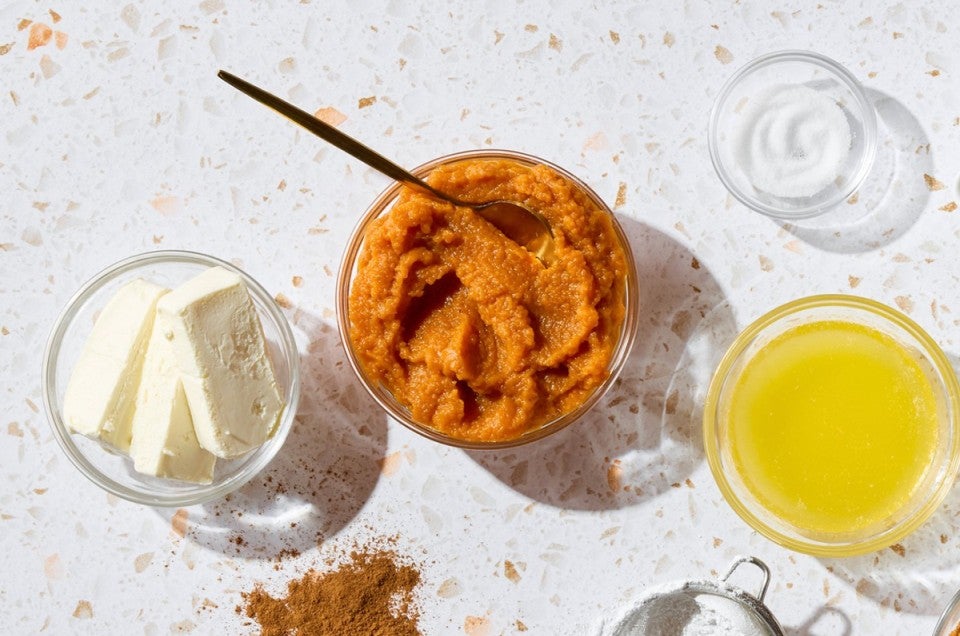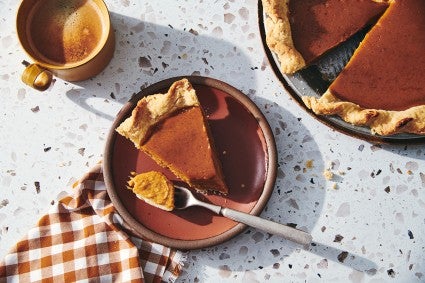


Pumpkin is the undeniable star of fall baking in quick breads, muffins, cakes, pies, and more. To make the most of pumpkin this harvest season, we’re answering some of your most commonly asked pumpkin baking questions.
Canned pumpkin purée should contain no additives and should have just one ingredient on the label: pumpkin. That label can actually be a bit confusing, as the USDA allows some varieties of winter squash to be called “pumpkin” when processed and canned. (They don’t draw a hard line between what defines a squash and a pumpkin.) So, even if it’s labeled “100% pumpkin,” a can might include purée from Dickinson, butternut, Hubbard, Boston Marrow, or Golden Delicious squash, which are close botanical relatives to the orange pumpkins we’re most familiar with. For instance, the ubiquitous Libby’s canned pumpkin is puréed from a special type of Dickinson pumpkin ... which is technically a variety of squash! Luckily, all of these winter squashes are delicious, bake interchangeably, and have the signature orange hue and dense texture you’d expect from a true pumpkin. As long as your canned purée just says “pumpkin” as its sole ingredient, you should be fine.
If you’d like to make the most of fresh pumpkins, you can make your own pumpkin purée to bake with, rather than reaching for a can. For the best flavor, choose a sugar pumpkin (also sometimes labeled a “cooking” or “pie pumpkin”) in the four- to eight-pound range. You’ll need to pierce it all over to create vent holes, then par-cook it in the microwave for about 10 minutes. After halving and seeding the partially cooked pumpkin (easier to do now that it’s softer!), roast it at 350°F for about 45 minutes (for a five-pound pumpkin) until the flesh is easily pierced with a fork. Next, scoop out the flesh and purée it in a food processor or mash it by hand. Drain off its excess moisture, then bake with it as you would canned pumpkin purée. See the full details here.

Not every recipe will call for a full can of pumpkin purée (though our Most Pumpkin Pumpkin Chocolate Chip Bread does!), and homemade purée may make more than you need for a particular recipe. To use up the leftovers, there are a few strategies you can employ. If your recipe calls for half a can of pumpkin (about 1 cup), you can double the recipe to use up a full can and give away the extra baked goods or stash them in the freezer.
Alternatively, freeze leftover purée in half-cup increments in a greased muffin tin; once solid, transfer the portions to an airtight freezer bag and freeze for up to a year. Then, defrost what you need and bake as directed. And if you have just a small amount leftover, it will keep for a few days in the fridge. To use it up, you can lightly sweeten it and swirl it into your morning oatmeal or yogurt, or try blending it into a smoothie. Or use it in recipes that don’t call for much pumpkin, such as Harvest Pumpkin Scones (2/3 cup), Pumpkin Biscotti (1/2 cup), or Pumpkin Swirl Cake (1/2 cup). Read more.
If your pumpkin pie recipe makes more filling than your pie shell can hold, don’t discard the leftovers! Transfer the extra filling to individual custard cups or ramekins and bake them alongside the pie; they should take about 25 to 30 minutes to cook at 400°F. Plus, it’s a great way to sneak a taste of the pie before serving it.

Canned pumpkin pie filling and canned pumpkin purée are two very different ingredients. A can of pumpkin purée has just one ingredient — pumpkin — making it a neutral base that you can sweeten, spice, and incorporate into your recipe as you wish. Canned pumpkin pie filling (sometimes also called “pumpkin pie mix”), on the other hand, is already sweetened and seasoned. Along with pumpkin, most canned fillings include sugar, salt, spices, and sometimes other additives, and are meant to be mixed with eggs and dairy for quick and easy pie baking. We don’t recommend substituting one for the other: If you substitute canned filling for canned purée in a recipe, you might end up with double the sweetness and spices that you intend, for instance.
A pumpkin pie is traditionally made with a custard filling that contains eggs, and when cracks form on the surface of a baked pumpkin pie, it’s the result of overcooking the custard. As the eggs coagulate and thicken the filling, they start to tighten up. If they tighten up too much, they create fissures at the edges and sometimes in the middle of your pie. Pulling the pie out of the oven within its optimum baking window — fully baked, but not overbaked (see more below) — will prevent any cracks from forming. (But if your pie does crack, you can always cover it with whipped cream and serve it — it will still taste delicious.) Read more.

To check on your pumpkin pie to assess doneness, give the pie plate a wiggle in the oven. If the entire filling of the pie is jiggling and mostly liquid, it’s not ready yet. A correctly baked pumpkin pie will jiggle more like Jell-O, with a 2" ring around the edges that looks set and a 4" ring in the center that looks not-quite-baked. If the filling barely jiggles or doesn’t move at all, it’s unfortunately overbaked. Read more.
Since pumpkin pie is made with a custard base containing eggs, it should always be stored in the refrigerator, ideally in a shallow, lidded storage container, where it will keep for three to four days. If you’re looking to make your pumpkin pie ahead of time, you can make both the pie shell and the filling ahead, but don’t assemble and bake the pie until the day you plan to serve it to avoid a soggy crust. Read more.
Pumpkin pie spice contains no pumpkin but is instead a blend of warm spices that complement pumpkin and other fall flavors. Every brand has its own proprietary mix of spices; King Arthur’s is a blend of ground ginger, cinnamon, nutmeg, and cloves. You can add this versatile mix instead of measuring out individual spices in recipes like pumpkin pie filling (of course!), pumpkin scones, pumpkin biscotti, pumpkin ice cream, or anywhere that a blend of warm baking spices is welcome. To make your own pumpkin pie spice blend, you can mix together 3/4 teaspoon ground cinnamon plus 1/4 teaspoon each ground nutmeg, ginger, and allspice or cloves.

It can sometimes be hard to taste pumpkin in a baked good: Because raw pumpkin is mostly water — up to 90% — it really doesn’t have much flavor. Rather than adding more purée to your recipe, which can make your bake soggy, concentrate the purée instead — a technique we use in our recipes for Fudgy-Chewy Pumpkin Cookies and The Most Pumpkin Pumpkin Chocolate Chip Bread. Slowly cook the pumpkin purée on the stovetop to evaporate excess moisture and caramelize the pumpkin, resulting in purée with a deeper, more complex flavor. You can also add spices to the purée as you cook it; heating spices releases their oils, making them more flavorful and fragrant. Just note that by preparing the pumpkin purée this way, you’ll be reducing the overall liquid in your recipe, so you may need to compensate by adding in additional milk or water to achieve the intended consistency and hydration of your bake. Read more.
Ready to bake with pumpkin? See our 16 best pumpkin recipes for fall baking.
Cover photo by Patrick Marinello; food styling by Kaitlin Wayne.

